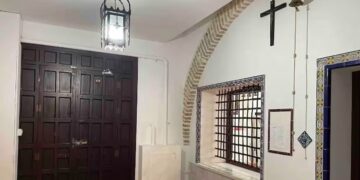The Domus Tiberiana, dating back almost 2000 years, hosted the rulers of the city in the imperial era.
An ancient Roman imperial palace atop the city’s Palatine Hill reopened to tourists on Thursday (September 21), nearly 50 years after it closed for restoration.
The Domus Tiberiana, dating back almost 2,000 years, hosted the rulers during the imperial period of the ancient city. The large palace allows for expansive views of the Roman Forum below.
The public can now visit it, after decades of structural restoration work aimed at supporting the building for safety reasons.
The excavations have brought to light finds dating back centuries Roman life following the decline of the empire.
The palace originally dates back to the time of Nero
The director of Colosseum The Archaeological Park, which includes the Palatine Hill, in a written description of the restored palace, defined it as “the palace of power par excellence”.
On the eve of the reopening, the official, Alfonsina Russo, quoted a first-century Roman poet as saying that the vast palace seemed “infinite” and that “its grandeur was just like the grandeur of the sky.”
Although the domus, or residence, takes its name from Tiberius, who ruled the empire after the death of Augustus, archaeological studies indicate that the foundations of the palace date back to the time of Nero, shortly after the fire of 64 AD which devastated much part of the city.
After the fall of the Roman Empire, the residence suffered centuries of abandonment, until, in 1500, the noble Farnese family developed an extensive garden around the ruins.
Thanks to the reopening of the palace to the public, visitors today can get a more precise idea of the route that the ancient emperors and their courts took on their way to the domus.
Hundreds of artifacts are on display
The English word “palatial” is inspired by the sumptuous imperial residence on top of the Palatine, one of the oldest The one in Rome seven hills.
The domus, built on the north-west side of the hill, is considered the first true imperial palace. The complex included, in addition to the emperor’s residence, gardens, places of worship, accommodation for the praetorian guard who protected the sovereign and a service area for workers that overlooked the Roman Forum.
The excavation and restoration work, also conducted during the coronavirus pandemic when tourism was at a minimum for months, helped archaeologists reconstruct what Russo calls centuries of history in a place that “has somehow been forgotten”.
On display for those visiting the reopened domus is a selection of hundreds of discovered artefacts, including metal and glass objects.
Statues, other decorations and ancient coins were also found.
Image:Getty Images










































Wow, cant wait to see all those ancient artifacts! Neros palace sounds so intriguing.
I hate to break it to you, but Neros palace is long gone, just like his moral compass. All youll find are ruins and reminders of his tyrannical reign. But hey, if youre into that kind of thing, have fun exploring!
Wow, cant wait to see all those ancient artifacts! History buffs, lets plan a trip ASAP!
I hate to burst your bubble, but those ancient artifacts are better off staying where they belong – in their original countries. Lets prioritize respecting cultural heritage over fueling our own curiosity.
Wow, I cant believe it took 50 years to restore that ancient Roman palace! Worth the wait?
Are you seriously complaining about a 50-year restoration? Do you have any idea how complex and delicate the process is? Its been a monumental effort, and the result is breathtaking. Some things are worth waiting for, my friend.
Wow, I cant believe they spent 50 years restoring this ancient palace. Waste of time?
I cant believe they wasted money reopening a palace! Who even cares about Nero?
Seriously? Nero is one of historys most notorious figures! Whether you like him or not, preserving historical sites is essential for understanding our past. Your lack of interest doesnt diminish its significance.
Who needs ancient ruins when we have modern architecture? #TimeToMoveOn
Ancient ruins hold the key to our past, preserving the rich history and cultural heritage that shaped our present. Modern architecture may be impressive, but it lacks the depth and significance that ancient ruins bring. Lets not dismiss the importance of our roots so easily. #RespectThePast
Wow, cant believe they spent 50 years restoring a palace that Nero built… waste of time?
Actually, restoring historical landmarks is far from a waste of time. It allows us to preserve our past, learn from it, and appreciate the beauty of ancient architecture. Plus, its a testament to human creativity and dedication.